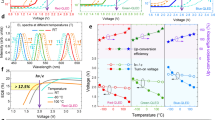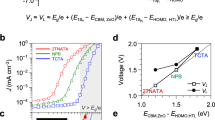Abstract
Minimizing heat accumulation is essential to prolonging the operational lifetime of quantum dot light-emitting diodes (QD-LEDs). Reducing heat generation at the source is the ideal solution, which requires high brightness and quantum efficiency at low driving voltages. Here we propose to enhance the brightness of QD-LEDs at low driving voltages by using a monolayer of large QDs to reduce the packing number in the emitting layer. This strategy allows us to achieve a higher charge population per QD for a given number of charges without charge leakage, enabling enhanced quasi-Fermi-level splitting and brightness at low driving voltage. Due to the minimized heat generation, these LEDs show a high power conversion efficiency of 23% and a T95 operation lifetime (the time for the luminance to decrease to 95% of the initial value) of more than 48,000 h at 1,000 cd m−2.
This is a preview of subscription content, access via your institution
Access options
Access Nature and 54 other Nature Portfolio journals
Get Nature+, our best-value online-access subscription
$29.99 / 30 days
cancel any time
Subscribe to this journal
Receive 12 print issues and online access
$259.00 per year
only $21.58 per issue
Buy this article
- Purchase on Springer Link
- Instant access to full article PDF
Prices may be subject to local taxes which are calculated during checkout





Similar content being viewed by others
Data availability
The data that support the findings of this study are available from the corresponding author upon reasonable request. They are also available at figshare: https://doi.org/10.6084/m9.figshare.22817639, or from the attached Source Data files. Source data are provided with this paper.
References
Sadi, T., Radevici, I. & Oksanen, J. Thermophotonic cooling with light-emitting diodes. Nat. Photon. 14, 205–214 (2020).
Ong, W.-L., Rupich, S. M., Talapin, D. V., McGaughey, A. J. H. & Malen, J. A. Surface chemistry mediates thermal transport in three-dimensional nanocrystal arrays. Nat. Mater. 12, 410–415 (2013).
Dai, X. et al. Solution-processed, high-performance light-emitting diodes based on quantum dots. Nature 515, 96–99 (2014).
Li, X. et al. Bright colloidal quantum dot light-emitting diodes enabled by efficient chlorination. Nat. Photon. 12, 159–164 (2018).
Shen, H. et al. Visible quantum dot light-emitting diodes with simultaneous high brightness and efficiency. Nat. Photon. 13, 192–197 (2019).
Deng, Y. et al. Solution-processed green and blue quantum-dot light-emitting diodes with eliminated charge leakage. Nat. Photon. 16, 505–511 (2022).
Tauc, J. The share of thermal energy taken from the surroundings in the electro-luminescent energy radiated from a p–n junction. Cech. Fiz. Z. 7, 275–276 (1957).
Wurfel, P. The chemical-potential of radiation. J. Phys. C 15, 3967–3985 (1982).
Su, Q. & Chen, S. M. Thermal assisted up-conversion electroluminescence in quantum dot light emitting diodes. Nat. Commun. 13, 369 (2022).
Lin, X. et al. Highly-efficient thermoelectric-driven light-emitting diodes based on colloidal quantum dots. Nano Res. 15, 9402–9409 (2022).
Li, N. et al. Ultra-low-power sub-photon-voltage high-efficiency light-emitting diodes. Nat. Photon. 13, 588–592 (2019).
Pal, B. N. et al. ‘Giant’ CdSe/CdS core/shell nanocrystal quantum dots as efficient electroluminescent materials: strong influence of shell thickness on light-emitting diode performance. Nano Lett. 12, 331–336 (2012).
Park, Y. S., Lim, J. & Klimov, V. I. Asymmetrically strained quantum dots with non-fluctuating single-dot emission spectra and subthermal room-temperature linewidths. Nat. Mater. 18, 249–255 (2019).
Qin, H. Y. et al. Single-dot spectroscopy of zinc-blende CdSe/CdS core/shell nanocrystals: nonblinking and correlation with ensemble measurements. J. Am. Chem. Soc. 136, 179–187 (2014).
Lim, J., Park, Y.-S. & Klimov, V. I. Optical gain in colloidal quantum dots achieved with direct-current electrical pumping. Nat. Mater. 17, 42–49 (2018).
Lim, J., Park, Y. S., Wu, K. F., Yun, H. J. & Klimov, V. I. Droop-free colloidal quantum dot light-emitting diodes. Nano Lett. 18, 6645–6653 (2018).
Lee, T. et al. Bright and stable quantum dot light-emitting diodes. Adv. Mater. 34, 202106276 (2021).
Qian, L., Zheng, Y., Xue, J. & Holloway, P. H. Stable and efficient quantum-dot light-emitting diodes based on solution-processed multilayer structures. Nat. Photon. 5, 543–548 (2011).
Neyts, K. A. Simulation of light emission from thin-film microcavities. J. Opt. Soc. Am. A 15, 962–971 (1998).
Yang, Y. et al. High-efficiency light-emitting devices based on quantum dots with tailored nanostructures. Nat. Photon. 9, 259–266 (2015).
Mashford, B. S. et al. High-efficiency quantum-dot light-emitting devices with enhanced charge injection. Nat. Photon. 7, 407–412 (2013).
Cao, W. et al. Highly stable QLEDs with improved hole injection via quantum dot structure tailoring. Nat. Commun. 9, 2608 (2018).
Lin, J. et al. High-performance quantum-dot light-emitting diodes using NiOX hole-injection layers with a high and stable work function. Adv. Funct. Mater. 30, 201907265 (2020).
Liu, D. et al. Highly stable red quantum dot light-emitting diodes with long T95 operation lifetimes. J. Phys. Chem. Lett. 11, 3111–3115 (2020).
Efros, A. L. et al. Band-edge exciton in quantum dots of semiconductors with a degenerate valence band: dark and bright exciton states. Phys. Rev. B 54, 4843–4856 (1996).
Pu, C. et al. Electrochemically-stable ligands bridge the photoluminescence–electroluminescence gap of quantum dots. Nat. Commun. 11, 937 (2020).
Chen, S. et al. On the degradation mechanisms of quantum-dot light-emitting diodes. Nat. Commun. 10, 765 (2019).
Sun, Y. et al. Investigation on thermally induced efficiency roll-off: towards efficient and ultra-bright quantum-dot light-emitting diodes. ACS Nano 13, 11433–11442 (2019).
Scholz, S., Kondakov, D., Lüssem, B. & Leo, K. Degradation mechanisms and reactions in organic light-emitting devices. Chem. Rev. 115, 8449–8503 (2015).
Benisty, H., Stanley, R. & Mayer, M. Method of source terms for dipole emission modification in modes of arbitrary planar structures. J. Opt. Soc. Am. A 15, 1192–1201 (1998).
Cho, C. & Greenham, N. C. Computational study of dipole radiation in re‐absorbing perovskite semiconductors for optoelectronics. Adv. Sci. 8, 2003559 (2020).
Acknowledgements
We gratefully acknowledge financial support from the National Natural Science Foundation of China (grant numbers U22A2072, 52272167, 62234006, 81788101, 11761131011, 51872275), the National Key R&D Program of China (grant number 2018YFA0306600), and the Postgraduate Cultivating Innovation and Quality Improvement Action Plan of Henan University (grant number SYLYC2022127).
Author information
Authors and Affiliations
Contributions
H.S. and F.F. conceived the concept and designed the experiments. H.S., F.F. and Z.D. supervised the project. Y.G., X.L. and J.S. synthesized the materials, fabricated the devices and collected the performance data of the QD-LEDs. B.L. and Y.S. developed the thermal simulation model and the electrical pump optical probe spectroscopy. F.F., H.S. and B.L. wrote the manuscript. All authors contributed to the scientific discussion and editing the manuscript.
Corresponding authors
Ethics declarations
Competing interests
The authors declare no competing interests.
Peer review
Peer review information
Nature Nanotechnology thanks Yanping Wang and the other, anonymous, reviewer(s) for their contribution to the peer review of this work.
Additional information
Publisher’s note Springer Nature remains neutral with regard to jurisdictional claims in published maps and institutional affiliations.
Supplementary information
Supplementary Information
Supplementary text, Figs. 1–17 and Tables 1–6.
Source data
Source Data Fig. 1
Fig. 1 source data in spreadsheet.
Source Data Fig. 2
Fig. 2 source data in spreadsheet.
Source Data Fig. 3
Fig. 3 source data in spreadsheet.
Source Data Fig. 4
Fig. 4 source data in spreadsheet.
Source Data Fig. 5
Fig. 5 source data in spreadsheet.
Rights and permissions
Springer Nature or its licensor (e.g. a society or other partner) holds exclusive rights to this article under a publishing agreement with the author(s) or other rightsholder(s); author self-archiving of the accepted manuscript version of this article is solely governed by the terms of such publishing agreement and applicable law.
About this article
Cite this article
Gao, Y., Li, B., Liu, X. et al. Minimizing heat generation in quantum dot light-emitting diodes by increasing quasi-Fermi-level splitting. Nat. Nanotechnol. 18, 1168–1174 (2023). https://doi.org/10.1038/s41565-023-01441-z
Received:
Accepted:
Published:
Issue Date:
DOI: https://doi.org/10.1038/s41565-023-01441-z
This article is cited by
-
Household alternating current electricity plug-and-play quantum-dot light-emitting diodes
Nature Communications (2024)



